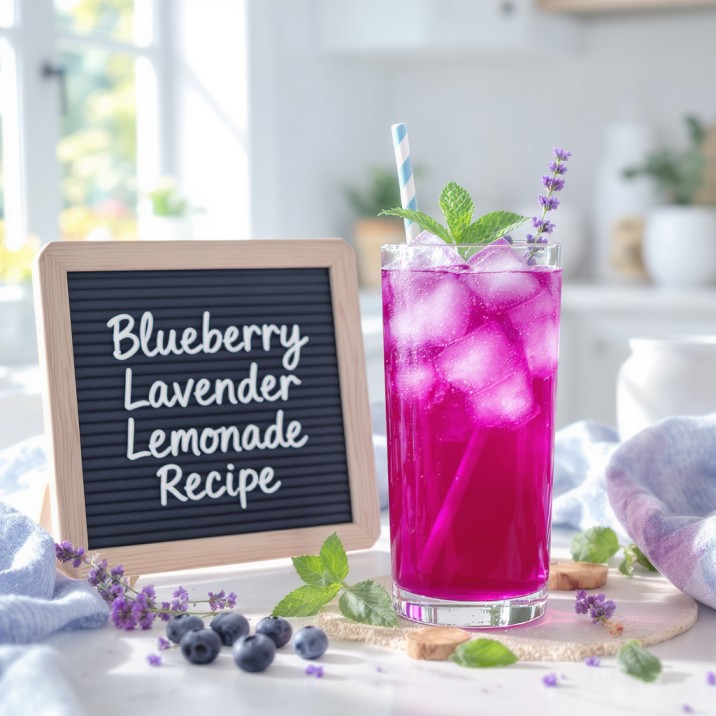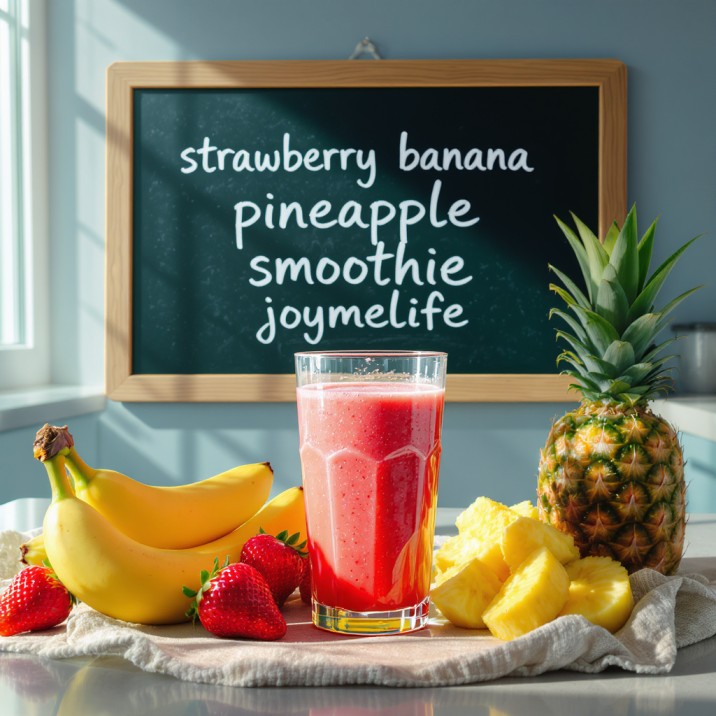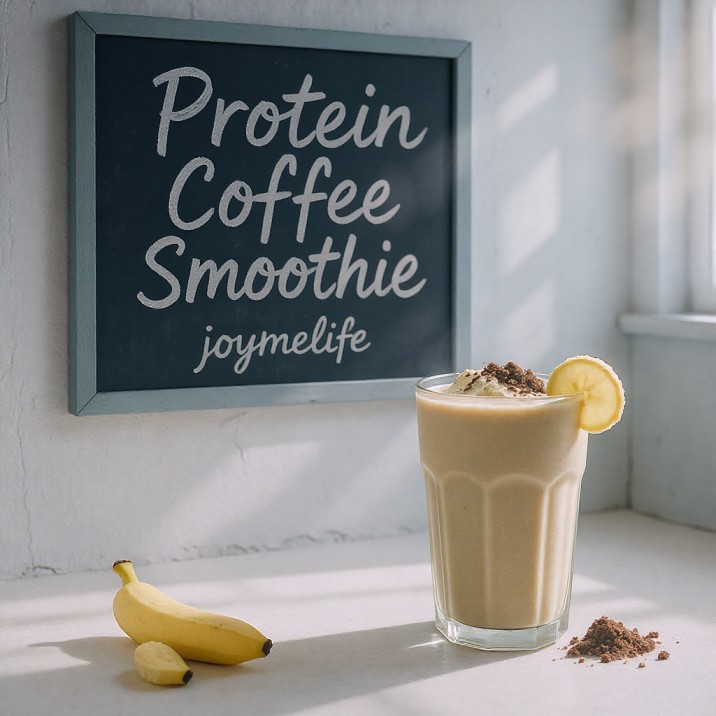
The Ultimate Guide to Healthy & Delicious Homemade Smoothie Recipes
Hello, culinary explorers and wellness enthusiasts! Welcome to your definitive resource for crafting incredible homemade smoothie recipes. Whether you’re a seasoned blending pro or just starting your journey into the vibrant world of smoothies, this guide is designed to inspire, educate, and help you create the perfect blended beverage every single time. Smoothies are more than just a drink; they’re a fantastic way to pack nutrients into your day, enjoy delicious flavors, and get creative in the kitchen. We’re thrilled to share this comprehensive guide, and for even more inspiration to enhance your well-being, be sure to visit joymelife.
This ultimate guide will cover everything from the very basics of how to make a smoothie to exploring specific categories like healthy smoothies, refreshing fruit smoothies, energizing breakfast smoothies, vibrant green smoothie recipes, and powerful protein smoothies. Get your blenders ready – it’s time to create some magic!
Welcome to the Wonderful World of Smoothies! Why Blend Your Way to Goodness?
Smoothies have skyrocketed in popularity, and it’s easy to see why. They offer a convenient, delicious, and highly customizable way to consume a wide array of beneficial ingredients.
The Power of a Perfectly Blended Drink
A well-crafted smoothie can be:
- Nutrient-Dense: An easy way to load up on vitamins, minerals, fiber, and antioxidants from fruits, vegetables, and other superfoods.
- Quick & Convenient: Perfect for busy mornings, a quick snack, or a post-workout refuel.
- Highly Customizable: Tailor ingredients to your taste preferences, dietary needs (vegan, gluten-free, low-sugar), and health goals.
- Deliciously Hydrating: A tasty way to contribute to your daily fluid intake.
- Great for All Ages: Loved by kids and adults alike!
What This Ultimate Guide Covers
- The fundamentals of smoothie making.
- How to create genuinely healthy and balanced smoothies.
- Delicious ideas for fruit-centric blends.
- Recipes and tips for energizing breakfast smoothies.
- The secrets to making tasty green smoothies.
- How to build effective protein smoothies.
- Expert tips, troubleshooting, and FAQs to ensure your smoothie success.
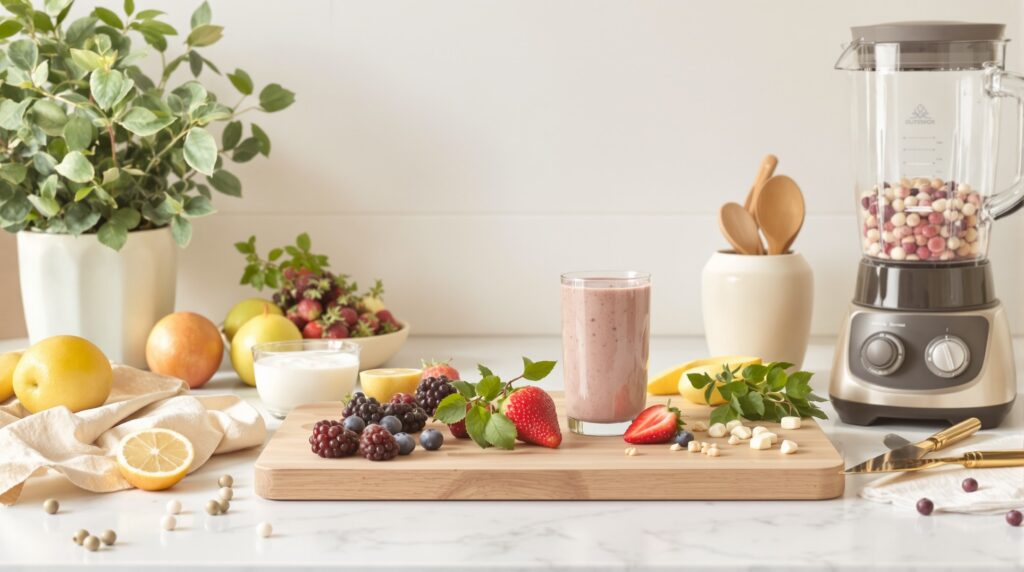
How to Make a Smoothie: Your Beginner’s Blueprint to Blending Perfection
New to the smoothie game or just want to brush up on the basics? This section breaks down how to make a smoothie like a pro.
Essential Equipment: What Blender Do You Really Need?
While you can make a smoothie with various tools, a good blender is your best friend.
- Personal Blenders (e.g., NutriBullet, Ninja Personal): Great for single servings, quick, and easy to clean. Ideal for simpler smoothies.
- Countertop Blenders (e.g., Vitamix, Blendtec, Oster, KitchenAid): More powerful and versatile, capable of handling tougher ingredients like frozen fruit, nuts, seeds, and fibrous greens, resulting in smoother textures. A high-speed blender is a fantastic investment if you plan to make smoothies regularly.
- Immersion Blenders: Can work for very simple, softer fruit smoothies but might struggle with frozen ingredients or achieving ultra-smooth results.
The Anatomy of a Great Smoothie: Core Components
Every great smoothie typically has a balanced combination of these elements:
Choosing Your Liquid Base (Water, Milks, Juices)
(Usually 1/2 to 1 cup per serving)
- Water: Calorie-free, hydrating, and lets other flavors shine.
- Dairy Milk: Adds creaminess and protein.
- Plant-Based Milks: Unsweetened almond, soy, oat, coconut, or cashew milk are excellent for dairy-free/vegan smoothies. Oat and coconut milk tend to be creamier.
- Coconut Water: Adds electrolytes and a subtle tropical sweetness.
- Fruit Juice (100%, unsweetened): Can add flavor and sweetness, but use in moderation due to natural sugar content (e.g., orange, apple, pineapple juice).
- Chilled Green or Herbal Tea: Adds antioxidants and unique flavors.
The Fruity Foundation (Fresh vs. Frozen, Best Choices)
(Usually 1 to 1.5 cups per serving)
- Frozen Fruit is King: Using frozen fruit is highly recommended as it chills and thickens the smoothie without needing ice (which can dilute flavor).
- Bananas: The ultimate smoothie base for creaminess and natural sweetness. Freeze ripe, peeled bananas in chunks.
- Berries: Strawberries (abundant in Romania around May/June!), blueberries, raspberries, blackberries – packed with antioxidants and vibrant color.
- Tropical Fruits: Mango, pineapple, papaya – lend a sweet, exotic flavor.
- Other Fruits: Peaches, nectarines, apples, pears, kiwi, melon.
- Fresh Fruit: Can be used, but your smoothie might be less thick and cold unless you add ice or other frozen ingredients.
Vegetable Power (Beyond Just Greens!)
(Optional, but great for a nutrient boost)
- Leafy Greens: Spinach (mildest), kale, Swiss chard.
- Cooked Sweet Potato or Pumpkin Puree: Adds creaminess, fiber, and Vitamin A.
- Beets (Cooked or raw in small amounts): For earthy sweetness and vibrant color.
- Carrots (Cooked or finely grated raw): For sweetness and beta-carotene.
- Cucumber or Celery: For hydration and a refreshing note.
Creamy Thickeners (Bananas, Avocado, Yogurt, Oats, Seeds)
Beyond frozen fruit, these help create that luscious texture:
- Frozen Banana: As mentioned, it’s a superstar.
- Avocado: 1/4 to 1/2 adds incredible creaminess and healthy fats (neutral flavor).
- Yogurt (Dairy or Plant-Based): Plain Greek yogurt for protein and tang; plain regular yogurt for creaminess.
- Rolled Oats: 1-2 tablespoons add fiber and thickness.
- Chia Seeds or Ground Flax Seeds: 1 tablespoon – they absorb liquid and create a gel-like consistency, thickening the smoothie.
- Nut Butters: Almond, peanut, cashew butter add creaminess, protein, and flavor.
Flavor Boosters & Superfood Add-ins (Spices, Extracts, Powders, Nut Butters)
Elevate your smoothie with these extras:
- Spices: Cinnamon, nutmeg, ginger, turmeric, cardamom.
- Extracts: Vanilla, almond, peppermint.
- Sweeteners (if needed): Maple syrup, honey, dates, stevia, monk fruit.
- Superfood Powders: Spirulina, chlorella, maca, acai, protein powder, collagen peptides, cacao powder.
- Nuts & Seeds: Almonds, walnuts, pumpkin seeds, sunflower seeds (blend well or use as topping).
- Citrus: Lemon or lime juice/zest to brighten flavors.
Step-by-Step: The Basic Blending Process
- Liquid First: Add your liquid base to the blender. This helps the blades move and prevents cavitation.
- Soft Stuff Next: Add fresh fruits/veggies, powders, sweeteners, yogurt.
- Frozen Last: Add frozen fruits, ice (if using), and harder ingredients like nuts.
- Secure Lid & Blend: Start on low speed, then gradually increase to high. Blend for 30-60 seconds, or until completely smooth and creamy. Use a tamper if your blender has one for thicker blends.
- Taste & Adjust: Check consistency and flavor. Add more liquid if too thick, more frozen fruit/ice if too thin, or more sweetener/flavorings as needed. Blend briefly again.
- Serve Immediately: Pour into a glass and enjoy!
Common Smoothie Problems & Easy Solutions (Thin, Thick, Chunky, Bitter)
- Too Thin? Add more frozen fruit (especially banana), a few ice cubes (sparingly), a tablespoon of chia seeds (let sit for 5 mins), or a bit of yogurt/oats.
- Too Thick? Add more liquid base (milk, water) a tablespoon at a time, blending until desired consistency is reached.
- Chunky or Gritty? Blend longer, ensure your blender is powerful enough for your ingredients, or chop harder ingredients smaller before blending. Sifting powders like protein or cacao can also help.
- Bitter (especially green smoothies)? Add more sweet fruit (banana, pineapple, mango), a pitted date, or a touch of maple syrup/honey. A squeeze of lemon or lime juice can also balance bitterness.
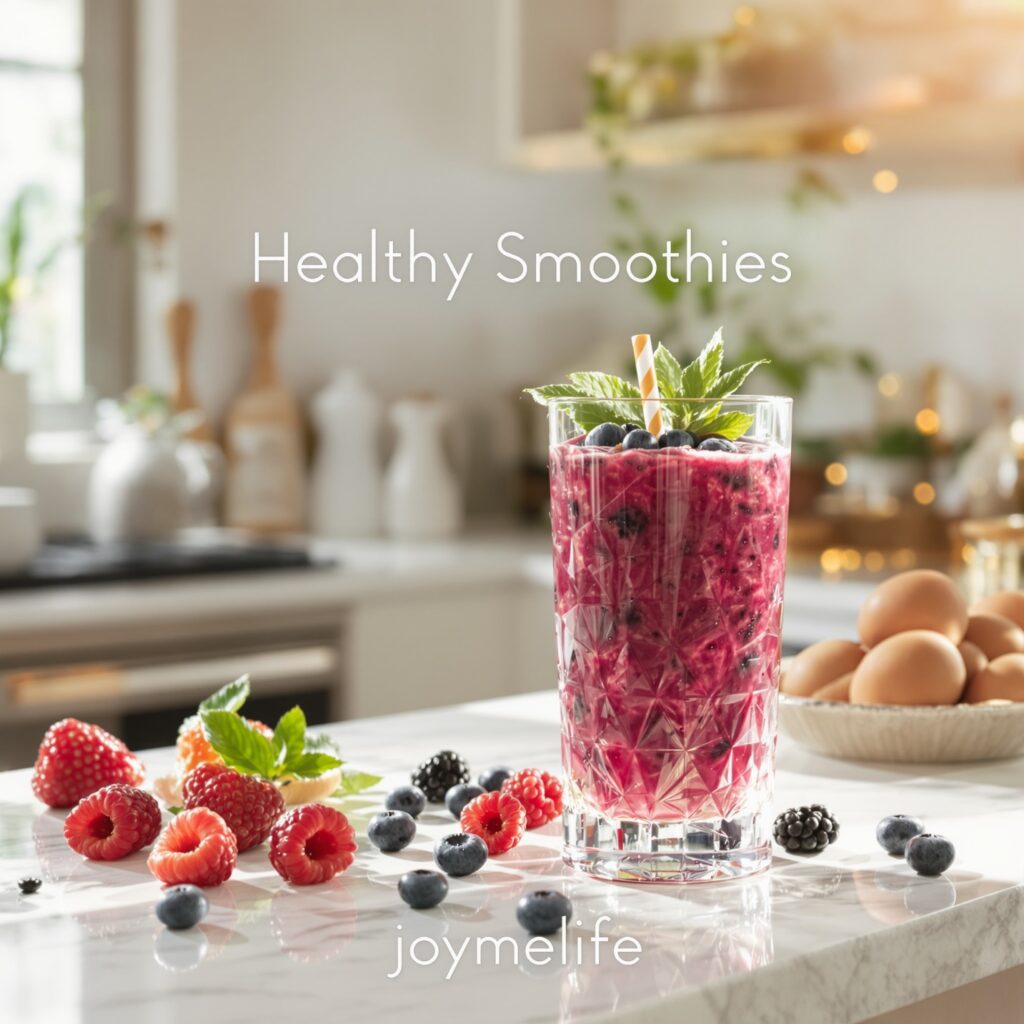
Healthy Smoothies: Blending for Wellness and Vitality
A healthy smoothie goes beyond just being tasty; it’s about packing in beneficial nutrients.
What Makes a Smoothie “Healthy”? Key Nutritional Considerations
A truly healthy smoothie typically features:
- Whole Foods: Prioritizing fruits, vegetables, nuts, and seeds over processed ingredients.
- Balanced Macronutrients: A good mix of carbohydrates (from fruits/veg), protein, and healthy fats.
- High Fiber: From fruits, vegetables, oats, chia/flax seeds.
- Low Added Sugar: Relying on natural sweetness from fruits or minimal natural sweeteners.
- Rich in Vitamins, Minerals, and Antioxidants.
Top Ingredients for Nutrient-Packed Healthy Smoothies
- Leafy Greens: Spinach, kale, Swiss chard, romaine.
- Berries: Blueberries, strawberries, raspberries, blackberries.
- Healthy Fats: Avocado, chia seeds, flax seeds, hemp seeds, almond butter, walnuts.
- Protein Sources: Greek yogurt, plant-based protein powder, nuts, seeds, tofu.
- Fiber Boosters: Oats, psyllium husk (use sparingly).
- Superfoods: Spirulina, maca powder, goji berries, turmeric, ginger.
Balancing Macronutrients for a Truly Healthy Blend
Aim for a good combination:
- Carbohydrates (for energy): Primarily from fruits and vegetables.
- Protein (for satiety & muscle support): From yogurt, protein powder, nuts/seeds.
- Healthy Fats (for satiety & nutrient absorption): From avocado, nuts/seeds, nut butters. This balance helps keep you full, energized, and prevents blood sugar spikes.
Example Concept: The Antioxidant Powerhouse Smoothie
- Blend: 1 cup mixed berries (frozen), 1/2 frozen banana, 1 handful spinach, 1 tbsp chia seeds, 1 cup unsweetened almond milk, optional: 1 tsp acai powder. This targets the “healthy smoothies” interest by focusing on high-antioxidant ingredients.
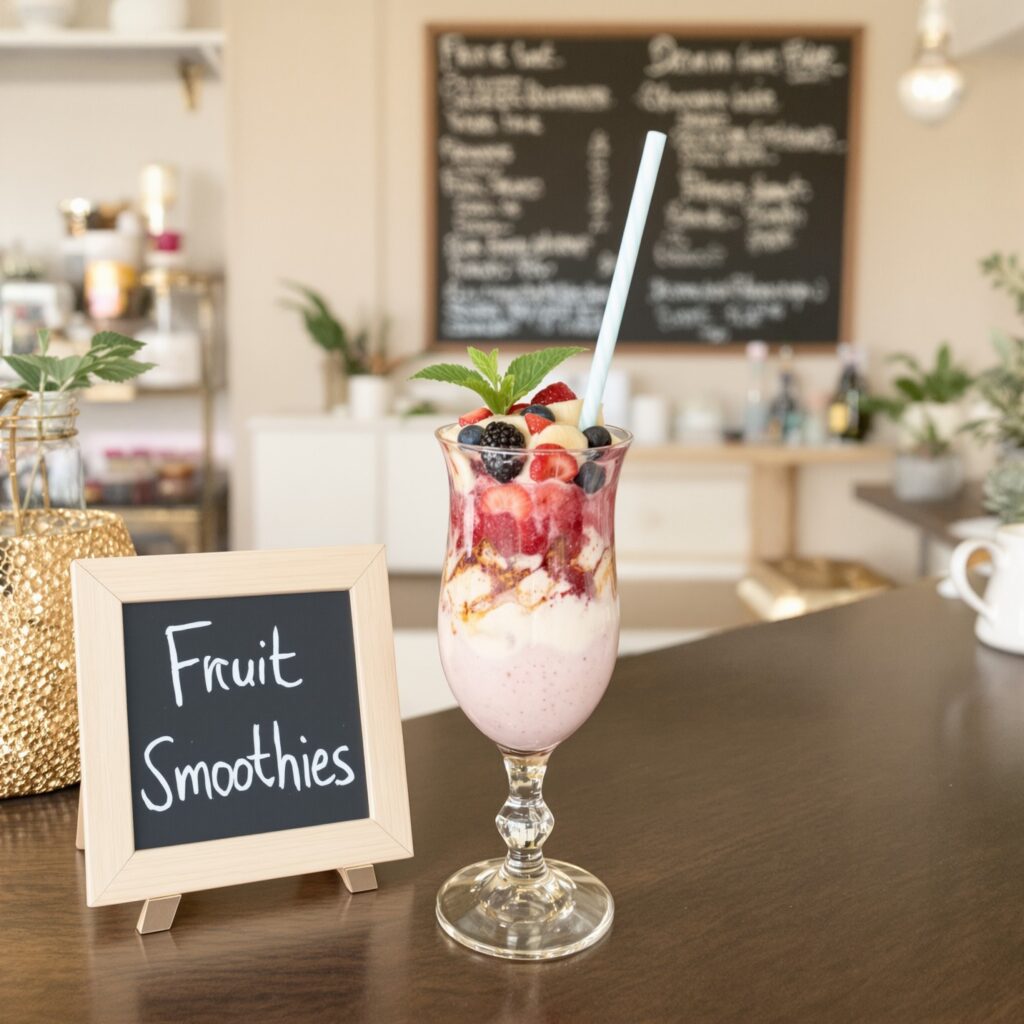
Fruit Smoothies: Classic, Sweet, and Naturally Delicious
Fruit smoothies are often the gateway into the smoothie world – they’re naturally sweet and universally loved.
The Joy of Single-Fruit & Combination Fruit Smoothies
- Single Fruit Focus: Strawberry banana, mango, pineapple – classic and delicious.
- Combinations: Experiment with your favorite fruit pairings. Think tropical (mango-pineapple-banana), berry blends, or peach-raspberry.
Tips for the Best Flavor: Ripe Fruits, Balancing Sweet & Tart (Seasonal Romanian Strawberries!)
- Use Ripe Fruit: Ripe fruit has the best flavor and natural sweetness, reducing the need for added sweeteners. This is a great time to mention using delicious, seasonal Romanian strawberries (“căpșuni”) when they are at their peak in May and June!
- Balance Sweet & Tart: If using very tart fruits (like some berries or citrus), balance them with sweeter fruits (banana, mango, pear) or a touch of natural sweetener.
- A Squeeze of Citrus: Lemon or lime juice can brighten fruit flavors significantly.
Achieving Vibrant Colors Naturally
- Let the fruits do the work! Berries give beautiful reds and purples, mango and pineapple give sunny yellows and oranges.
- Be mindful of mixing colors that might turn muddy (e.g., too many different dark berries with a hint of green).
Example Concept: Tropical Paradise Fruit Smoothie
- Blend: 1 cup frozen pineapple chunks, 1/2 cup frozen mango chunks, 1/2 frozen banana, 1 cup coconut water or light coconut milk, optional: squeeze of lime juice. This showcases a classic fruit smoothie.
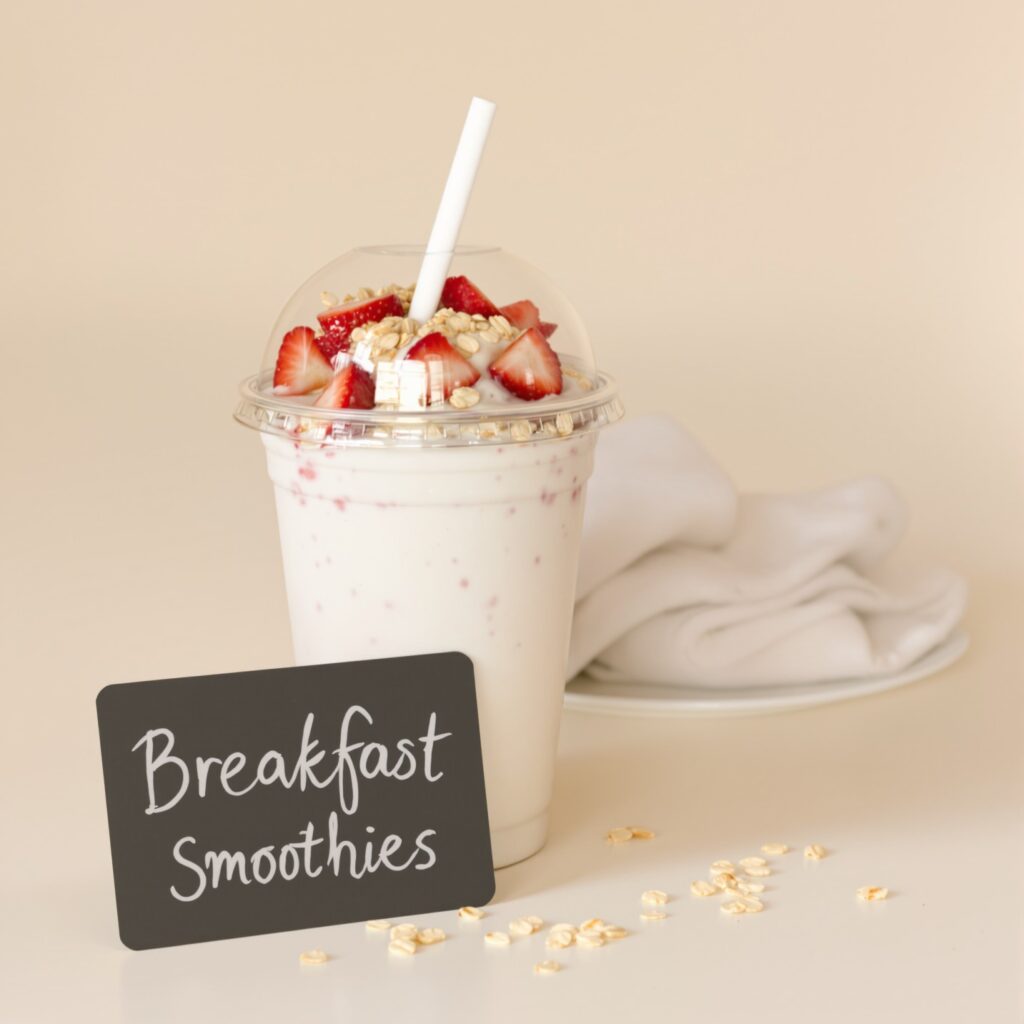
Breakfast Smoothies: The Perfect Grab-and-Go Morning Meal
A well-designed breakfast smoothie can be a quick, nutritious, and filling start to your day.
Why a Smoothie is a Great Breakfast Choice
- Quick & Easy: Blends up in minutes.
- Nutrient-Packed: A great way to get fruits, veggies, protein, and fiber first thing.
- Portable: Easy to take on the go.
- Digestible: Often easier on the stomach than a heavy breakfast.
Key Ingredients for Satiety and Sustained Energy (Fiber, Protein, Healthy Fats)
To avoid a mid-morning crash, ensure your breakfast smoothie contains:
- Fiber: Oats, chia seeds, flax seeds, fruits with skin, leafy greens.
- Protein: Greek yogurt, protein powder, nut butter, tofu, hemp seeds.
- Healthy Fats: Avocado, nuts/seeds, nut butter. These slow down digestion and provide lasting energy.
Quick Prep Tips for Busy Mornings (Smoothie Packs!)
- Prepare individual freezer packs with pre-portioned frozen fruits, greens, oats, seeds, and even protein powder.
- In the morning, just dump a pack into the blender, add your liquid, and blend! This saves precious time.
Example Recipe: The Energizer Breakfast Smoothie
- Ingredients:
- 1 cup unsweetened almond milk or oat milk
- 1/2 frozen banana
- 1/2 cup frozen mixed berries
- 1/4 cup rolled oats
- 1 tablespoon almond butter (or other nut/seed butter)
- 1 scoop vanilla or unflavored protein powder (optional)
- 1 handful spinach (optional)
- Instructions:
- Blend all ingredients until smooth. This is a complete breakfast smoothie designed for energy.

Green Smoothie Recipes: Your Delicious Dose of Daily Greens
Green smoothie recipes are a fantastic way to boost your vegetable intake, especially leafy greens.
The Amazing Benefits of Drinking Your Greens
Leafy greens like spinach and kale are nutritional powerhouses, rich in vitamins (A, C, K), minerals (iron, calcium), fiber, and antioxidants. Blending them into a smoothie makes them easy to consume and digest.
How to Make Green Smoothies Taste Good (No More “Lawn Clippings”!)
The key to a delicious green smoothie recipe is balancing the greens with the right fruits and flavors:
- Start Mild: Baby spinach is very mild and almost tasteless in smoothies. It’s a great starting point.
- Sweet Fruits are Your Friends: Banana, pineapple, mango, and sweet apples or pears can easily mask the taste of greens.
- Citrus Power: Lemon or lime juice brightens the flavor and cuts any bitterness.
- Ginger: A small piece of fresh ginger adds a nice zing.
- Don’t Overdo the Greens (Initially): Start with one handful and gradually increase as you get used to the taste.
Best Greens for Smoothies (Spinach, Kale, Swiss Chard & Beyond)
- Spinach: Mildest flavor, blends easily.
- Kale: More robust flavor, very nutritious. Remove tough stems. Lacinato (dinosaur) kale is often milder than curly kale.
- Swiss Chard: Earthy flavor, colorful stems can be used too.
- Romaine Lettuce: Very mild, adds water content.
- Other options: Parsley, cilantro (in small amounts for specific flavor profiles), beet greens.
Balancing Fruits and Veggies in Green Smoothies
A common ratio to start with is about 60% fruit to 40% greens. You can adjust this based on your preference. The goal is to get the benefits of the greens while still enjoying the taste.
Example Recipe: The Beginner-Friendly Green Goddess Smoothie
- Ingredients:
- 1 cup unsweetened almond milk or coconut water
- 1 large handful fresh baby spinach
- 1/2 frozen banana
- 1/2 cup frozen pineapple or mango chunks
- 1 tablespoon chia seeds or flax seeds (optional)
- Squeeze of lemon or lime juice (optional)
- Instructions:
- Blend all ingredients until very smooth. This green smoothie recipe is designed to be palatable and refreshing.
Protein Smoothie: Fueling Your Fitness and Recovery
A protein smoothie is an excellent way to increase your protein intake, support muscle growth and repair, and keep you feeling full.
Why Add Protein to Your Smoothie? Benefits for Muscle & Satiety
Protein is essential for building and repairing tissues (including muscle), producing enzymes and hormones, and it’s very satiating, meaning it helps you feel fuller for longer. This makes a protein smoothie great for post-workout recovery or as a meal replacement.
Best Sources of Protein for Smoothies (Powders: Whey, Casein, Plant-Based; Whole Foods: Greek Yogurt, Nuts, Seeds, Tofu)
- Protein Powders:Whey Protein: Fast-digesting, great for post-workout. Comes in isolate (lower carb/fat) and concentrate.
- Casein Protein: Slow-digesting, good for sustained protein release (e.g., before bed, though less common in a morning smoothie).
- Plant-Based Protein Powders: Pea, soy, rice, hemp, or blends. Great for vegans or those with dairy sensitivities.
- Whole Food Protein Sources:Greek Yogurt (Dairy or Plant-Based): High in protein, adds creaminess.
- Nuts and Nut Butters: Almonds, peanuts, cashews, etc.
- Seeds: Chia, flax, hemp, pumpkin seeds.
- Silken Tofu: Adds creaminess and protein with a neutral flavor.
- Cooked Quinoa (small amount): Adds complete protein and texture.
Pre-Workout vs. Post-Workout Protein Smoothies: What’s the Difference?
- Pre-Workout: Might focus more on easily digestible carbs for energy (e.g., banana, oats) along with some protein. Often lighter.
- Post-Workout: Typically higher in protein to aid muscle repair and recovery, often with some carbs to replenish glycogen stores. The specific ingredients in your protein smoothie can be tailored to these goals.
Example Concept: The Ultimate Post-Workout Recovery Protein Smoothie
- Blend: 1 cup unsweetened almond milk, 1 scoop vanilla or chocolate protein powder, 1/2 frozen banana, 1/2 cup frozen berries (for antioxidants), 1 tbsp almond butter, 1 handful spinach. This targets the “protein smoothie” interest with a balanced recovery formulation.
General Expert Tips for Smoothie Success (Beyond the Basics)
These apply to almost any smoothie recipe you make!
Getting the Texture Just Right: Adjusting Thickness
- Thicker: More frozen fruit, less liquid, add yogurt/avocado/oats/chia.
- Thinner: More liquid. It’s always easier to thin a smoothie than to thicken it, so start with less liquid.
Layering Ingredients in Your Blender for Optimal Performance
As mentioned in “How to Make a Smoothie,” a good general order is:
- Liquids
- Fresh fruits/veggies, powders, soft ingredients
- Frozen fruits/ice. This helps the blender work efficiently.
Sweetening Your Smoothie Naturally
- Ripe fruits (especially bananas, mangoes, dates) are often all you need.
- If more sweetness is desired, opt for Medjool dates, maple syrup, raw honey (if not vegan), or stevia/monk fruit for sugar-free options.
Cleaning Your Blender: The Quick & Easy Way
- Rinse immediately after use.
- Then, fill halfway with warm water, add a drop of dish soap, put the lid on, and blend for 20-30 seconds. Rinse, and it’s clean!

Smoothie FAQs: Your Top Questions Answered
Let’s tackle some common questions about homemade smoothie recipes.
Q1: Can smoothies help with weight loss?
A: Yes, healthy smoothies can be a helpful tool for weight loss if they are part of a balanced diet and calorie-controlled eating plan. They should be rich in protein and fiber to promote satiety and made with whole, nutrient-dense ingredients, avoiding excessive sugars or high-calorie fats. They can replace less healthy, higher-calorie meals or snacks.
Q2: How long do homemade smoothies last in the fridge?
A: Smoothies are best consumed fresh, ideally within a few hours of making, as nutrients (especially Vitamin C and B vitamins) can degrade with exposure to air and light. If you must store it, put it in an airtight container filled to the brim and refrigerate for up to 24 hours. The color and texture might change, and some separation may occur; stir or shake well before drinking.
Q3: Are store-bought smoothies as healthy as homemade ones?
A: Not always. Many store-bought smoothies can be very high in sugar (from fruit juices, purees, and added sweeteners), calories, and may contain artificial ingredients or preservatives. Homemade smoothies give you complete control over the ingredients, allowing you to prioritize whole foods and minimize added sugars, making them generally a healthier option. Always check the nutrition labels on store-bought versions.
Q4: What’s the best way to make a smoothie without a banana for thickness?
A: Great alternatives to banana for thickness include: * 1/4 – 1/2 ripe avocado * 1/2 cup plain Greek yogurt (or plant-based yogurt) * 1/4 cup rolled oats * 1-2 tablespoons chia seeds or ground flax seeds (allow to sit for 5-10 mins to thicken) * 1/2 cup frozen mango or pineapple chunks * Steamed-then-frozen cauliflower florets (surprisingly neutral and creamy!)
Q5: Can I use water instead of milk in my smoothies?
A: Absolutely! Water is a great calorie-free, hydrating liquid base for smoothies. Your smoothie might be slightly less creamy than if you used milk (especially whole dairy milk or creamy plant milks like oat or coconut), but it allows the flavors of your fruits and vegetables to shine through more clearly. If using water, you might want to ensure you have other creamy elements like banana, avocado, or yogurt.
Conclusion: Blend Your Way to a Healthier, Happier You with Endless Smoothie Recipes!
You are now armed with a wealth of knowledge to create an incredible array of smoothie recipes right in your own kitchen! From the foundational steps of how to make a smoothie to crafting specialized healthy smoothies, delicious fruit smoothies, filling breakfast smoothies, vibrant green smoothie recipes, and powerful protein smoothies, the possibilities are truly endless. Homemade smoothies are a fantastic, enjoyable, and customizable way to boost your nutrient intake and cater to your specific health goals and taste preferences. We hope this ultimate guide from joymelife empowers you to blend with confidence and creativity.
So, embrace the process, experiment with flavors and ingredients, and discover your own signature smoothie creations. Here’s to a healthier, happier, and more delicious life, one blend at a time!
What are your all-time favorite smoothie recipes or ingredient combinations? Share your tips and inspirations in the comments below!
Remember to check out our other amazing recipes and lifestyle tips at joymelife! Your journey to a joyful life starts here. Thanks for reading!



